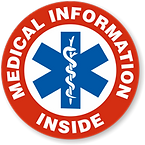MedicalAlertCard.org


QR Codes

SCAN TO READ TECHNOLOGY
SCAN ME
GENERIC V-CARD
"Older" Version 2.1 Sample
This is a static QR code
The info is stored in the
dots in plain text format
What is a QR code?
Short for quick response, QR Codes are scannable barcodes that store data and they are also commonly used to redirect users to information stored on internet servers. QR Codes can be placed on anything including business cards, countertop displays, signage, posters and anywhere you want to direct people.
How do QR Codes work?
A QR Code works similarly to barcodes at the supermarket. Each QR Code consists of black squares and/or dots, all representing different pieces of information. Like other 2D codes, QR codes are omni-directional meaning that they can be read from any angle. When scanned, the unique pattern in the code translates into readable data. This process occurs in less than a second.
Users can quickly scan the code with any modern smartphone. Newer phones utilize the camera and older phones often use a free QR Code scanning app.
Static vs. Dynamic QR Codes
A static QR Code contains information that cannot be modified once it has been produced. Any typo or misspelling cannot be corrected and will require the creation of a brand new QR Code. The good news is that static codes never expire and the data is wholly encoded within the dots of the QR code. Static QR Codes are considered 100% secure as they do not require internet access to read the information. Static QR Codes tend to look quite busy because all of the information is actually encoded within the dots of the QR Code.
Static QR Codes are ideal for storing information that never changes. The use of Static QR Codes can be challenging if the information needs to updated because the old code must be replaced with a newly printed Static QR Code. If the data you want to store in a QR code is made of only alphanumeric characters, a single QR code can hold up to 4000 characters.
DYNAMIC QR CODES
Dynamic QR Codes "point" to "data" that is stored on a computer server and requires internet access to retrieve the information. Therefore, a paid subscription service is also generally required. Dynamic QR Codes redirect or "point" users to a specific URL whose information can be changed at any time, and as often as necessary. Dynamic QR Codes are "alive" and they are perfect for maintaining healthcare records that are subject to frequent or periodic change such as medical conditions, medication lists and dosages.
The greatest benefit of Dynamic QR Codes is the ability to change the information without having to change the printed code itself. Dynamic QR Codes also have the ability to gather scanning metrics which reveal the time, location, and device type used for each scan.
Dynamic QR Codes are also much more pleasant to visualize because they only contain a single line of information which points to a URL. Think of a Dynamic QR Code as your own personal web-page.